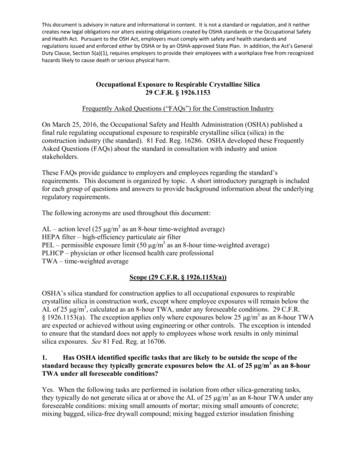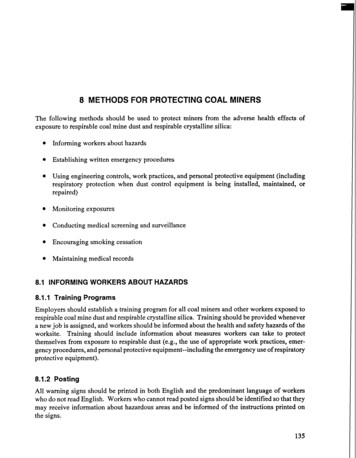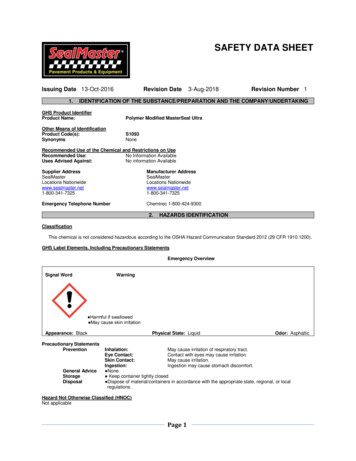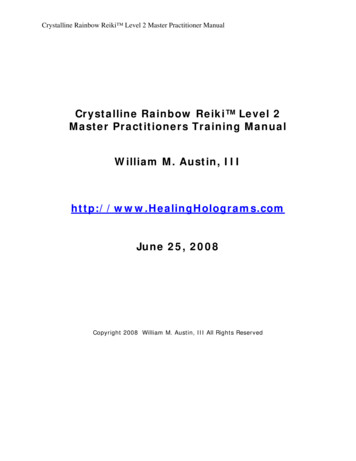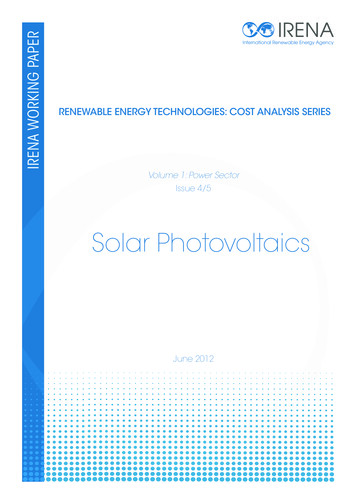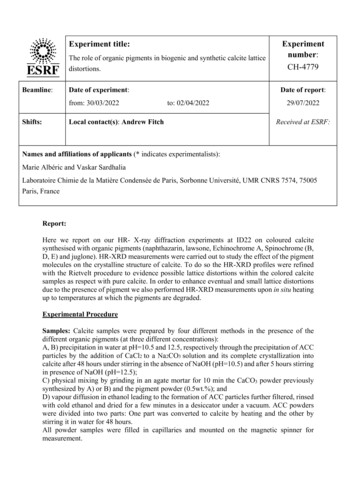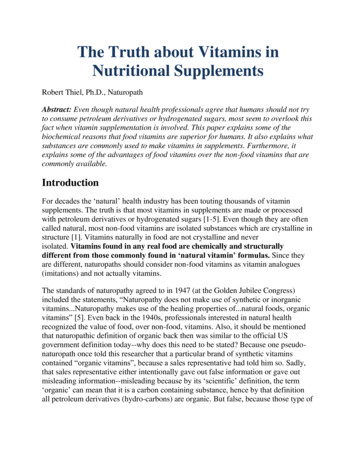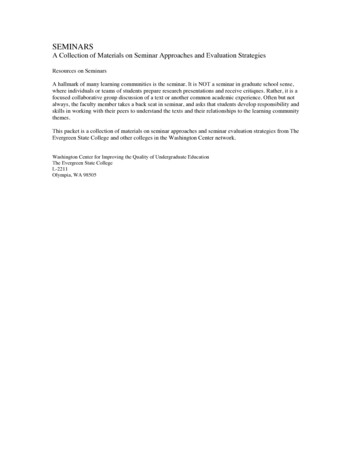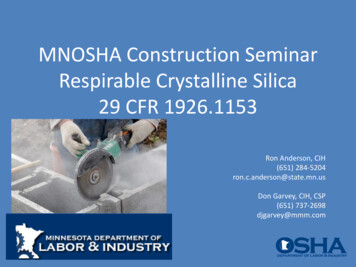
Transcription
MNOSHA Construction SeminarRespirable Crystalline Silica29 CFR 1926.1153Ron Anderson, CIH(651) 284-5204ron.c.anderson@state.mn.usDon Garvey, CIH, CSP(651) 737-2698djgarvey@mmm.com
History Sept. 12, 2013: Published the proposed ruleand request for comments Federal OSHA adopted the final rule March 25,2016 Minnesota OSHA adopted the final ruleSept. 26, 2016
General industry effective dates All obligations of this section June 23, 2018– except medical surveillance (i)(1)(i) June 23, 2018, for those exceeding the PEL for 30 ormore days a year June 23, 2020, for those exceeding the action level 30or more days a year Hydraulic fracturing operations in gas and oilindustry – June 23, 2018– except medical surveillance (i)(1)(i) andengineering controls (f)(1) (June 23, 2021)
Construction effective dates All obligationscommenceSept. 23, 2017 Requirements forsample analysis(d)(2)(v)commenceJune 23, 2018
Permissible exposure limits (PELs) Action level of 25 µg/m3 as an eight-hour TWA Permissible exposure limit of 50 µg/m3 as aneight-hourTWA
New definitionRespirable crystalline silica means quartz,cristobalite and/or tridymite contained inairborne particles that are determined to berespirable by a sampling device designed tomeet the characteristics for respirable-particlesize-selective samplers specified in theInternational Organization for Standardization(ISO) 7708:1995: Air Quality — Particle SizeFraction Definitions for Health-related Sampling
Exposure assessment Initial exposure assessment Periodic exposure assessments– fixed schedule option– performance option Additional exposure assessments– changes in operation Or, in construction, comply with Table 1
Construction – Table 1 Specified exposure control methods The employer shall fully and properlyimplement:– the engineering controls– work practices– respiratory protection Specified for the task on Table 1, unless theemployer complies with paragraph (d)
Sample from Table 1Table 1. Exposure control methods for selected construction operationsEquipment/task(i) Stationarymasonry sawsEngineering and workpractice control methodsUse saw equipped withintegrated water deliverysystem that continuouslyfeeds water to the bladeOperate and maintain tool inaccordance withmanufacturer’s instructionsto minimize dust emissionsRequired respiratory protectionand minimum assigned protectionfactor (APF) 4 hr/day 4 hr/dayNoneNone
Sample from Table 1Table 1. Specified exposure control methods when working with materials containingcrystalline silicaEquipment/taskEngineering and work practicecontrol methodsRequired respiratoryprotection and minimumassigned protectionfactor (APF) 4 hr/day 4 hr/day– when used outdoorsNoneAPF 10– when used indoors or in an enclosedareaAPF 10APF 10Use saw equipped with integrated waterdelivery system that continuously feedswater to the blade(ii) Handheldpower saws(any bladediameter)Operate and maintain tool in accordancewith manufacturer’s instructions tominimize dust emissions
When implementing control measuresspecified in Table 1, each employer shall:(i)(ii)for tasks performed indoors or in enclosedarea, provide a means of exhaust asneeded to minimize the accumulation ofvisible airborne dustfor tasks performed using wet methods,apply water at flow rates sufficient tominimize release of visible dust
(iii) for measures implemented that include anenclosed cab or booth, ensure theenclosed cab or booth:A. is maintained as free as practicable from settled dustB. has door seals and closing mechanisms that work properlyC. has gaskets and seals that are in good condition and workproperlyD. is under positive pressure maintained through a continuousdelivery of fresh airE. has intake air that is filtered through a filter that is 95 percentefficient in the 0.3 to 10.0 um range (for example MERV-16 orbetter)F. has heating and cooling capabilities
Employee notification of assessmentresults Within five days (construction)or 15 days (general industry) ofconducting an assessment theemployer shall notify in writingeach affected employee Whenever an exposureassessment indicates employeeexposure is above the PEL, theemployer shall describe in thewritten notification thecorrective action being taken toreduce employee exposures toor below the PEL
Engineering controls Wet methods Ventilation Enclosures Elimination Substitution
Regulated areas General industry:establish a regulatedarea to limit access toareas that exceed thePEL Construction, generalindustry: develop awritten exposurecontrol plan
Written exposure control plan A description of the tasks thathave exposure A description of theengineering controls, workpractices and respiratoryprotection used A description of thehousekeeping measures tobe used A description of proceduresto restrict access andminimize the number ofemployees exposed Shall be reviewed annually
Housekeeping The employer shall not allow dry sweeping ordry brushing where such activity couldcontribute to employee exposure unless wetsweeping, HEPA vacuuming or other methodsare not feasible Compressed air shall not be used to cleanclothing or surfaces unless used in conjunctionwith a ventilation system to capture the dustcloud or no alternative method is available
Respirators Used when engineeringcontrols are notsufficient to reduceexposures below thePELs Requires– a written respiratoryprotection program– medical evaluation– employee Training– fit testing
Medical surveillance Construction: forworkers who weara respirator 30 ormore days a year General industry:for workers whoare exposed abovethe action level for30 or more days ayear
Medical surveillance Medical and work history Physical exam withemphasis on respiratory A chest X-ray A pulmonary function test Testing for latenttuberculosis Any other tests deemedappropriate by the PLHCP At least every three years
Hazard communication Must beincluded inhazardcommunicationtraining Must addresscancer, lungeffects, immunesystem effectsand kidneyeffects
Employee information and training Health hazards associated with silica Specific tasks that could expose employees to silica Specific measures the employer has implemented toreduce exposures to silica, including engineeringcontrols and work practices Contents of the standard Purpose and description of the medical surveillanceprogram Construction: identity of the competent person
Recordkeeping Exposure assessment records Medical surveillance records Respirator medical evaluationand fit testing Training records Injury and illness records
MNOSHA’s newsletter Safety Lines Safety Lines is an online, quarterly publicationof the Minnesota Department of Labor andIndustryIts purpose is to promote occupational safetyand health and to inform readers of thepurpose, plans and progress of MinnesotaOSHASign up to receive email notification aboutthe publication of new editions atwww.dli.mn.gov/OSHA/SafetyLines.asp
This material can be provided to you in different formats (audio, Braille orlarge print) if you call Minnesota OSHA at (651) 284-5050 or 1-877-470-6742.Material contained in this publication is in the public domain and may bereproduced, fully or partially, without permission of the MinnesotaDepartment of Labor and Industry or Minnesota OSHA. Source credit isrequested but not required.For more information, contact:Minnesota Department of Labor and IndustryOccupational Safety and Health Division443 Lafayette Road N.St. Paul, MN 55155Phone: (652) 284-5050, 1-877-470-6742Email: osha.compliance@state.mn.usWeb: www.dli.mn.gov/MnOsha.aspRevised Feb. 7, 2014
Department of Labor and Industry or Minnesota OSHA. Source credit is requested but not required. For more information, contact: Minnesota Department of Labor and Industry Occupational Safety and Health Division 443 Lafayette Road N. St. Paul, MN 55155 Phone: (652) 284- 5050, 1- 877-470-6742 Email: osha.compliance@state.mn.us
